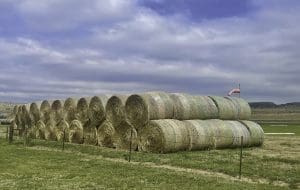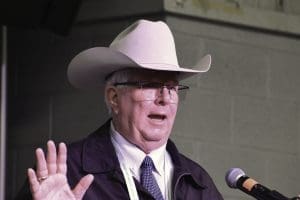By Larry Stalcup Contributing Editor

The splendor of spring graced the rolling prairie surrounding Canadian, Texas. April showers brought Panhandle pastures to life. The emerald scenes were signs of early recovery from the devilish Smokehouse Creek Fire that took the lives of three people and thousands of cattle and other livestock.
Countless homes, barns and other dwellings and thousands of miles of fencing were also burned by the deadly blaze from late February through nearly 10 days in March. Some seven weeks later, the April 23-24 Texas A&M AgriLife Hemphill County Beef Conference was a blessing for those who experienced the 1.2-million-acre firestorm, an event that is still receiving national attention.
“The conference theme was ‘Better Ranching for Better Life.’ It provided folks with a lot of hope,” said an emotional Andy Holloway, Hemphill County Extension Educator and head of the conference’s organizing committee. “We helped producers with encouragement that life will go on. Close to 1,000 people attended. It meant a lot to me. We completed the race we were challenged to run, despite the hardships caused by the wildfires.”
Ranchers, farmers, allied industry reps and others came to Canadian from more than 20 different states. Speakers addressed subjects ranging from cattle markets, the weather, estate planning and beef cattle genetics, to pasture and cattle risk management, ag financing and new-age brush control.
Risk Management to the Rescue
Price protection to protect ranch equity is advisable, said conference speaker Jason Smith, Texas A&M AgriLife Extension beef cattle specialist in Amarillo. He recommended that producers consider the U.S. Department of Agriculture (USDA) Risk Management Service’s Livestock Risk Protection (LRP) and Weaned Cattle Risk Protection (WCRP) programs.
“Many of us market feeder cattle in limited numbers of marketing groups,” he said. “We subject ourselves to the risk associated with short-term market movements. LRP is intended to protect against downward market movement. WCRP is intended to protect against a catastrophic yield loss.”
LRP is used to set a floor prices for cattle, it’s “not a profit-making tool,” Smith said, noting that LRP acts similarly to a put option or even a futures contract. The LRP indemnity is based on the difference between the coverage price and the Feeder Cattle Index. The cattle must be sold within 60 days of the coverage’s expiration date and is independent of the actual price received for the cattle.
WCRP was available this year as a pilot program in South Dakota, Nebraska, Colorado and Texas. Enrollment deadline was Jan. 31 for 2024 coverage. There’s hope it will be extended for 2025 coverage. USDA indicates that a WCRP policy covers revenue losses to perils such as drought, floods, diseases or blizzards. Losses can be due to animal deaths, since that impacts overall production, or loss of weight or production due to the natural disaster.
Like LRP, Smith said WCRP and other RMA insurance programs are purchased through licensed ag insurance agents. For more on these risk protection tools, visit https://www.rma.usda.gov/informationtools/livestockreports/.
After the Fires
Texas A&M economists estimate the wildfires resulted in $123 million or more in losses. Producers who suffered cattle losses from the frenzy of wildfires could be eligible for livestock indemnity and other federal disaster-related payments. Additional relief sources are available from the Texas and Southwestern Cattle Raisers Association, which is coordinating some $2 million that has been donated to its wildfire relief fund. To apply for disaster relief, go to https://tscra.org/disasterreliefapp/.
Texas Farm Bureau also has more than $1 million in wildfire/disaster relief funds available to victims of the wildfires. To apply, go to https://texasfarmbureau.org/panhandle-wildfire-relief-fund/. Another $340,000 or more is available via a wildfire fund established by Capital Farm Credit. Additional disaster relief funds are also available through regional lending institutions and other resources. Ranchers impacted by the fires have been slow in applying for assistance. “Ranchers don’t like to ask for things,” Holloway said. “They’re humble. They say, ‘Take it to my neighbor.’ But we have wonderful people and companies giving this money. They want to help. Please apply for the money. It is here to help.”

Thousands of bales of hay have been donated from across Texas and numerous states. Truckloads continue to arrive at temporary hay yards across Hemphill, Roberts, Gray, Hutchinson and other counties. “We have five hay yards in Hemphill County that maintain hay inventories so that a month from now, ranchers can obtain hay if it doesn’t rain. We still need several slow soaking showers to help our pastures recover.”
On May 1, the Texas House of Representatives Investigative Committee on the Panhandle Wildfires reported that both the Smokehouse Creek and Reamer Creek fires were caused by downed power poles owned by Xcel Energy. There have been numerous lawsuits filed against Xcel Energy, Osmose Utility Services and others by homeowners and ranchers.
The committee reported that along with the Texas A&M Forest Service, dozens of regional volunteer fire departments aided in helping get the fires under control. The wear and tear on their equipment was extensive. The committee called for major state assistance, including a recommendation that the state legislature appropriate to fully fund some $170 million in pending grant requests from rural volunteer fire departments for new equipment and training.
On May 2, Rep. Jackson joined U.S. Sen. Ted Cruz in introducing the Livestock Indemnity Program Enhancement Act to the USDA to establish an additional payment rate through the Livestock Indemnity Program for excessive unborn livestock death losses due to gestating livestock losses.
Holloway’s praised the dozens of beef conference volunteers and the Canadian community for helping make the conference a success. He also thanked some 100 trades how exhibitors for their support.
“We’re already planning the 2025 conference, which will be next April 29-30,” he said. “We will discuss new ideas and strategies that will be beneficial to regional producers.”
Here’s hoping that the 2025 conference will not be in the wake of another disaster.
“The conference theme was ‘Better Ranching for Better Life.’ It provided folks with a lot of hope…we helped producers with encouragement that life will go on.” – Andy Holloway
Ranching 20 Years From Now
The Hemphill County Beef Conference saw a panel of cattle industry leaders look into their crystal balls to project the state of cattle and ranch operations 20 years from now.
Led by moderator Dr. David Lusk, West A&M University (WTAMU)animal science professor, they tackled issues like future types of cattle, ranch employees, ranch management and technology.
Panelists were Laura Burandt, co-manager and co-owner at Long Arroyo Cattle, a Panhandle area cow-calf operation; Mark Gardiner, head of Gardiner Angus Ranch in
Ashland, Kansas, and co-founder of U.S. Premium Beef; Dr. Kevin Pond, Dean of the WTAMU Paul Engler College of Agriculture and Natural Sciences; and Donnell Brown, head of the fifth-generation RA Brown Ranch in Throckmorton, Texas.
Here are some of their comments on ranching in the year 2044 and beyond:
Laura Burandt A graduate of the TCU Ranch Management School, Burandt said the diversity among ranch hands would grow as the industry changes. She sees future ranch managers in four different categories; one raised in a ranch family, the second from an allied industry, the third a ranch manager without a family ranch, and the fourth “an empire builder,” either starting from scratch or enlarging the operation to make it work.
“I am a one and a four,” she said. “I grew up on a small cow-calf operation that depended on outside income.” She later joined an operation devoted to rotational grazing and other advanced production methods. “What matters is if the cow breeds and can raise a viable calf. We matched the cow with the environment and forage, and matched the production cycle to the environment.”
She added that there’s much new technology on the way, including one “to measure nutrient density.” Producers should use new technology to have a “plan A, B and C in place” in the event changes are needed that are dictated by weather, disaster, markets, input costs or other factors.
Donnell Brown He sees a “huge shift to a younger generation on the ranch.” That may include new land ownership from those investing more in real estate, “people who have created wealth and maybe made it another industry.”
Brown foresees more “blended cows” in a wider range of cross-breeding to help improve production efficiency. “We have produced 17 different breeds on our ranch,” he said. “I long for the day when both colors of Angus work together. I think cattle will be predominately Angus moving forward, but a majority of cows will be hybrid cows.
“Science has told us that hybrid vigor is needed to improve survivability, sustainability and fertility that we have often struggled to get in purebred populations. I call them Goldilocks cows – not too big, not too small, but just right.”
Brown said new technology will improve methods to take “waste fat and convert it to taste fat,” adding that new genetic monitoring is enabling producers to identify better genetics in cows. He reminded conference attendees, “The beef industry has never moved this fast before, and it will never move this slowly again.”
Mark Gardiner The innovative Angus breeder said his family’s operation always welcomes college interns, a trend that will continue for many reasons. “I want attitude and effort; that of being there and being present,” he said. “I like young people with multiple ideas and thoughts.”
The Gardiners have been steadfast in using expected progeny differences (EPDs) and other technology to improve genetics. A strong work ethic made it happen. “I was fortunate to be born in a ranching family,” Gardiner said. “It was a work right, not a birthright. But for the next generation, we may need to make it more fun. We need to open our minds and possibilities.”
With much of the High Plains more suitable for cattle than crop production, Gardiner said it would be important to continue producing low-input cattle. “But we sell outputs to make a living,” he added, pointing out that multi-traits in Angus cows help get more out of the land.
He said AI, the artificial intelligence one, would enhance future cattle production, “but the cowboy life still matters. I want to do traditional AI, but we need to face the future.”
Gardiner said the industry can’t have the attitude of, “We can’t build a windmill because we’re too busy hauling water.”
Dr. Kevin Pond The WT dean had issues with relying mainly on one breed. “Why would we worry about breeds when have the great opportunity and technology to take the best traits from different animals?” he questioned. “Why not use all those qualities to produce a consistent product for the consumer?
“Angus has done a tremendous job of marketing and has changed the industry completely. But there will be other traits from other breeds that can be put together to make them better. Pretty soon, CAB [Certified Angus Beef] may be (determined) with some other measurement. It may not be predominately black-hided.”
Pond said new ag school students are from a broader spectrum, and in many cases, the majority are female.
“We have a lot of students who have a burning desire to do something different,” Pond stressed, noting that students will use AI – “but not on a test.” However, WT will use much AI in its new feedlot, scheduled to be built within the next year.
The panel agreed that consumer demand will have a greater impact in the type of cattle that will be produced two decades from now. Gardiner concluded, “I don’t care if they (cattle) are black, yellow or purple, it’s all about beef. We still need to get better.”







